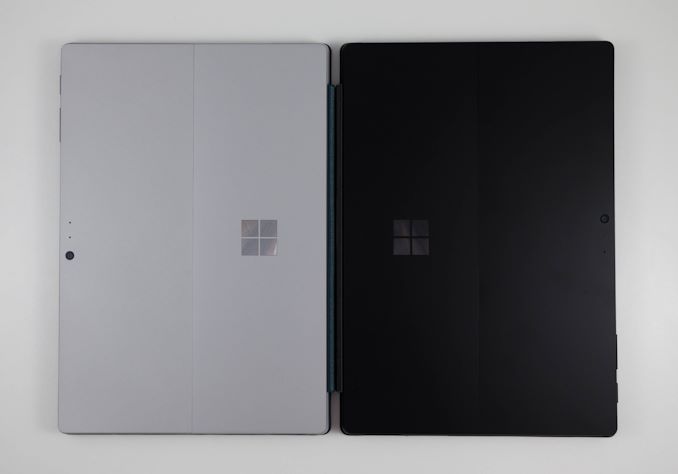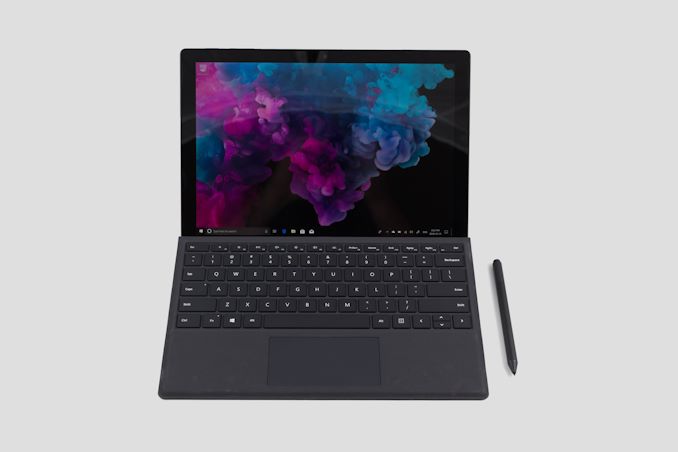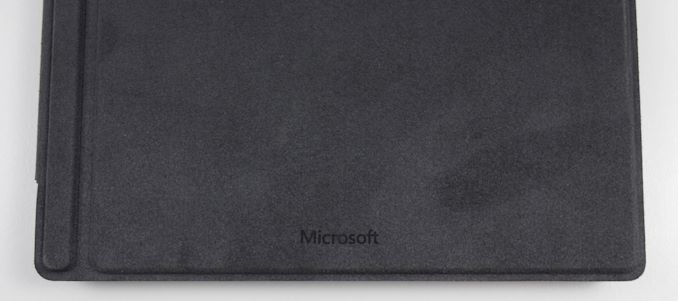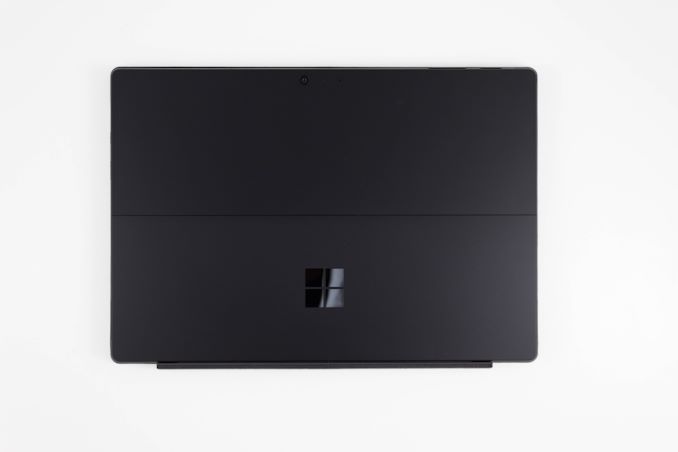The Microsoft Surface Pro 6 Review: More Than A Color
by Brett Howse on October 16, 2018 3:01 AM EST- Posted in
- Laptops
- Microsoft
- Surface
- Tablets
- Surface Pro
- Surface Pro 6
Final Words
At the launch event in NYC on October 2nd, the Surface Pro 6 seemed like a mild refresh of an already established line, and that’s not even necessarily a bad thing. The exterior is more or less identical to the outgoing 2017 model, albeit with a new color option to sit beside the platinum that we’ve seen on all Surface devices for the last couple of years. The pen was immensely improved just last year, and carries over. The alcantara type covers were introduced last year, and once again carry over to this model. There’s still not a USB-C port on Surface Pro, and for no really good reason.
 Surface Pro 2017 (left) in Platinum vs Surface Pro 6 (right) in Black
Surface Pro 2017 (left) in Platinum vs Surface Pro 6 (right) in Black
But after using the device for the last couple of days, there’s more than meets the eye. The big change with Surface Pro 6 is the move to Kaby Lake Refresh, and the doubling of the CPU cores that entails, and unsurprisingly the performance of this model is much better than all previous versions. The lack of an Intel Iris GPU option was unavoidable, since it no longer exists in the 15-Watt range, but even so, the Iris in last year’s Surface Pro was restricted by the low TDP anyway, and as such didn’t always offer the expected performance boost.
Microsoft has also taken the opportunity to improve the already class-leading display in the Surface Pro 6. It’s just as accurate as ever, but now offers a noticeable bump in contrast ratio. If you want an accurate display in the PC space, only Microsoft calibrates every device they sell, and the 12.3-inch display on the Pro lineup offers everything you’d expect in a premium PC, with high resolution, accurate colors, and full sRGB coverage. It would be nice to see Microsoft use Surface as a line to drive HDR adoption, but apparently, we’re not quite there yet. The 3:2 aspect ratio is still the right choice for a device like this, and that’s apparent when you see the competition all adopting the same aspect ratio on their lineups.
The other nice addition this year is even better battery life, with a significant jump across all of our tests. The Surface team achieved that without increasing the rated battery capacity, which if a guess had to be made, would come down to an improved display TFT since the display is still the biggest power draw by a wide margin.
Finally, there’s the new old black color, which we hadn’t seen on Surface since the Surface Pro 2. It looks good, but it does get dirty much quicker than the platinum that they used before, with fingerprints and hand oils showing up very quickly. The other nice benefit of the platinum color is that any scratches to the finish should be mostly masked by the color of the underlying metal, but it’s too early to tell how durable the new black finish will be, so this may or may not be an issue. Likely it will be though, unless you are someone who never scratches a portable device.
This was also our first chance to test out the passively cooled Surface Pro, since we were only able to test the Core i7 model last year, which did feature a fan. The Core i5-8250U in the Surface Pro 6 was able to maintain an average of over 15 Watts of power dissipation indefinitely, although the power would drop periodically to maintain surface temperatures. The added benefit of a completely silent device can’t be overstated either, and unless you really need maximum performance, the fanless model is probably the way to go.
Nothing big has changed for this year, but this version still seems like a nice improvement regardless. If anything, it’s the release cadence of Surface that is the most baffling. It seems like Microsoft is concerned with having another launch go as poorly as it did with Surface Pro 4 and Surface Book, where the Skylake power management issues caused them a lot of grief. When the company moved to Kaby Lake in summer 2017, it fixed those issues, but Kaby Lake was launched in the second half of 2016, meaning Microsoft was selling the Skylake models for far longer than they needed to. Microsoft seems to want to refresh when they want to, but it’s not always to their benefit, and rarely good for their customers, for them to sit on products well after the rest of the competition has moved to the latest products inside. The Surface Pro 6 is launching with Kaby Lake refresh right as Whiskey Lake is launching, which isn’t going to be a dramatic improvement in performance, but it does include hardware mitigations to Spectre and Meltdown which will now not be available in the Surface Pro for the foreseeable future. We are seeing the 2018 Surface Pro 6 launching with the same wireless adapter as the Surface Pro 3 had in 2014, and even in 2014 it wasn’t the best Wi-Fi adapter. The USB-C is another example of where they’ve decided to dig in their heels for almost no reason, since having a second USB port would probably be welcomed by more users than those that want to use mini DisplayPort, even though that’s available over USB-C anyway.
Microsoft’s Surface lineup has always been about a premium device, and to showcase their software, and the Surface Pro 6 delivers on that front. Despite the somewhat questionable update cadence, and even the lack of USB-C, the changes that are here are all very welcome. No one is going to complain about more color options, and the improvements to performance and especially battery life are a boon to all Surface Pro users. These changes bring it to a level that Surface Pro has never been to before. Microsoft is being safe with the Surface Pro, but it was already the class leader, so it’s hard to fault them on that. The Surface Pro 6 is a much bigger update than just a new color.













80 Comments
View All Comments
Speedfriend - Tuesday, October 16, 2018 - link
For all the talk of a lack of innovation from Intel, the charts comparing the various generations are quite incredible. 60% improvement in single threaded, 175% in multi, combined with a 100% improvement in battery life.Microsoft has got a winning device here, I see more Surface Pros at conferences than any other type of laptop including Macs, though still behind iPads
fallaha56 - Tuesday, October 16, 2018 - link
you’re bigging up numbers from years and years ago....vanilla_gorilla - Tuesday, October 16, 2018 - link
I'm guessing these are Microsoft conferences? Not sure where you're seeing more Surface devices than Macs or Thinkpads or HP laptops. Surface sells in incredibly small numbers compared to those other manufacturers. And what conferences have more iPads than anything? I'm not sure if you're lying or if you're attending conferences selling timeshares to senior citizens?althaz - Wednesday, October 17, 2018 - link
You're just wrong here. Apple definitely sells more than Microsoft (Lenovo is around the level of Apple with HP and Dell far outstrip the rest). But the different isn't huge. There's no world in which "Surface sell in incredibly small numbers" compared to any other manufacturer's line.When you are talking about premium laptop-ish devices, the Surface line is comparable to the other popular makes. It's smaller than the top 4 - but in its category not by all that much.
melgross - Wednesday, October 17, 2018 - link
I don’t know what conferences you go to, other than those for IT, but I’ve never seen one of these anywhere.With all of the talk about these, as though they’re really important, Microsoft still has to show that they can grow yearly sales beyond the 3 million (maybe!) they barely managed so far. With SurfaceBook sales lower than 500,00 a year, and the Surface PC supposedly in the tens of thousands a year, none of these lines are doing anything near well.
TheinsanegamerN - Wednesday, October 17, 2018 - link
Except that speed increase comes from lower power usage. At the same clocks, intels chips are still not any faster then 3 years ago.Yeah, great, you went from "slow" to "decent speed.". The iGPU is still no faster, max performance is still dependent on the cooling system, and anything that isnt restricted to CFL light-bulb power levels is no faster.
name99 - Wednesday, October 17, 2018 - link
Looking at this sort of improvement misses the reason for concern with Intel.The original CPU (i3-4020Y) is 1.5 GHz, no turbo.
The end point CPU (i7-7660U) is 2.5GHz base, turbo to 4GHz.
Now from one point of view, it's nice that Intel has managed to boost frequency this way while not moving too far outside the power envelope. That helps low power devices (like Surface!) AND it helps large core count server chips.
BUT look at the larger story. It's about lower power, NOT about higher achievable frequencies. The tech that got this does not help that much in boosting the frequency of your 120W desktop CPU in single-threaded mode. Meanwhile, there's been very little improvement in IPC, which can improve performance at the high end.
If you care about some classes of devices, yes, great progress by Intel. But if you care about single-threaded performance at the high end, what's shown here is irrelevant, and just highlights that Intel either through inability or lack of interest is not delivering anything close to the same improvements at the high end.
GreenReaper - Friday, October 19, 2018 - link
The original was a i5-3317U dual-core hyperthreaded 1.7Ghz -> 2.6Ghz turbo. I have one. It's still quite nice, although with the cooling it has it can only maintain ~1.9Ghz under full load with BOINC.Surface Pro 2 and 3 were significant steps back in terms of single-threaded performance, to achieve the "thin and light" goal and improve battery life. That was probably the right decision for the target audience, but given I use my Pro 1 as a second screen I'm glad I got it cheap when the Pro 2 came out.
Eliadbu - Friday, October 19, 2018 - link
The days of CPU improvement are near the endIPC improvement is near the limit adding more instruction to the already large CISC is doubtfully helpful. We are just about the end on how far we can push the clock speed and and adding more cores and threads is useful but to a certain degree. And this is also true for AMD. A new direction should be taken like instead of stack of general purpose CPUs for a all consumers a family of specialized CPUs would good idea.
wr3zzz - Tuesday, October 16, 2018 - link
What is the downside of using a U-class CPU without active cooling? Surface Pro i5 is not the only one. Huawei's Matebook also pairs U-class 15Watt chips without fans.Why won't more companies do this?